Undress Sabretache
The last decade of the century saw the Sam Browne system becoming ubiquitous for active service overseas. By the end of the century it was also becoming standard for domestic peace manoeuvres.
Photographs show that Sam Brown leather scabbards worn before 1896 were made to accommodate the 1822 light cavalry sword. However, photographs often show Hussar officers on exercise wearing their dress shoulder belts with undress sabretaches and swords on white slings.
The undress sabretache was of plain black leather. The 10th Hussars were the only regiment known to wear a device on it.
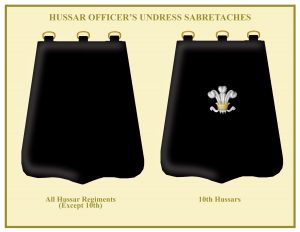
OFFICERS’ HORSE FURNITURE
Apart from the Shabraque, the horse furniture of hussar officers was the same as for all cavalry.
Like the heavy cavalry, the brass badges affixed to the bit boss and breast plate (often erroneously called the Martingale) were mostly of regimental patterns, in that the centre of the garter was the regimental badge.
The notable exception was the 10th Hussars whose bridle, reins and straps were of black leather. The cheek pieces, headstall and noseband were on a scarlet cloth backing and decorated with white cowrie shells.
These small shells were also laid upon the forehead cross-piece, the curb rein, the breast plate and straps as well as the crupper. For some reason, the bridoon rein was spared! Instead of a throat plume, there was a black leather hanging strap where it was, on the lower part widened and rounded, all heavily laden with cowrie shells. Another similar, smaller version was attached to the crupper straps on either side.
This exquisite leatherwork was used by the regiment from, at least the 1790s until 1914 and on the Drum Horse as late as 1961.
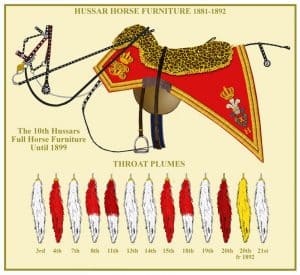
The colours of the throat plumes of all the other regiments corresponded with the busby plume (with the lower colour, of that on the busby, being the top one on the throat plume)
The Shabraque, like that of the heavy cavalry, was to be of authorised regimental patterns and not be re-introduced into regiments which had discontinued it or may discontinue it.
This was obviously an early attempt, in this era, for the powers-that-be at the Horse Guards to dispense with a costly piece of equipment. It required large swathes of high grade cloth and was embellished with vast amounts of gold lace.
The regulation was, as usual a compromise laden with ambiguity. Often, the reason to discontinue the shabraque was a practical one. Regiments sent overseas were not allowed to take the shabraque and required to put them in store before embarking. Regiments away for many years returned to find them moth eaten, mouldy or otherwise damaged and therefore the decision was made for them.
The hussar Shabraque was four foot four inches front to back and three foot one inch deep at the rear points which were swallow-tailed. The fore-corners in front were squared to fit over the wallets.
The ground colour was blue for all regiments except the 10th which was scarlet. The edges were trimmed with a 3 inch gold lace band for three of the old hussar regiments (7th, 8th and 15th) and the recently raised 18th. The 10th and 11th had double 2 ½ inch bands as did the remaining regiments – ex light dragoons and ex Bengal cavalry.
The 13th and 14th Hussars had rounded rear and fore-corners.
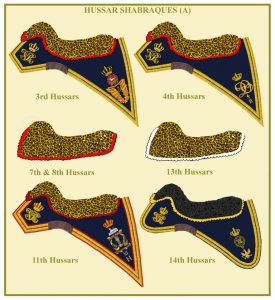
For all regiments, the fore-corners were decorated with the crown over the VR cypher in gold lace. Over the Shabraque was a Leopard-skin edged with scalloped cloth in regimental colours. The 14th Hussars had a black lambskin instead of the leopard-skin.
The 7th, 8th, 13th, 19th, 20th and 21st regiments had largely discontinued the shabraque before 1881. In most cases, after returning home after lengthy overseas tours in India and Africa.
To replace the shabraques, these regiments had the leopard-skin enlarged in front to fit over the wallets and edged in scalloped lace. This was the style used by most regiments after abolition in 1896.
The 21st Hussars had a unique leopard-skin, which included the entire pelt including legs and head (above the crupper). This style of leopard-skin was adopted by several regiments after the shabraque was abolished. The 19th Hussars adopted a black lambskin on their return from Egypt in 1887.
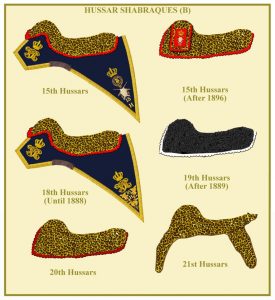
The remaining regiments had the following features on the hind corners of their shabraques:
The 3rd Hussars: – Crown over garter with motto on a purple ground. Within the garter the white horse of Hanover on a green base with a scarlet background. Beneath the garter a spray of laurel leaves on each side upon which are 12 battle-honour scrolls in gold on scarlet ground – two below the garter and five on each side. The number “3” over “H” between the laurel sprays.
The 4th Hussars: Crown over the Queen’s cypher intertwined in gold with “4” over H beneath.
The 10th Hussars: Crown over Prince of Wales feathers with motto. Beneath, a U shaped scroll with “Prince of Wales’s Own” on the left side and “10th Royal Hussars” on the right. In the middle of the scroll the letter “X” and below the scroll “H”.
The 11th Hussars: A gold grown above the Sphynx with the legend “EGYPT” in silver. Below the sphinx, a three sided scroll in blue edged gold with “PRICE ALBERT’S” on the top part, “OWN” on the left part and “HUSSARS” on the right part all in gold letters.
Within the scrolls, the Crest of the Prince Consort. Below the crest, the motto “Treu und Fest” on a scroll. “XI” over “H” below that. In addition, The gold lace double border was edged with crimson cloth and the crowns on the rear and fore part were backed with the same.
The 14th Hussars: A gold Crown over Garter, VR cypher within. Below the cypher the Prussian Eagle in gold.
The 15th Hussars: A gold Crown over Garter, Royal Crest within. Crossed white flags* below points down. Below is “15” over “H”. After 1896 the regiment incorporated the crown over crossed flags with the “15” below on the fore-corners of the leopard-skin.
The 18th Hussars: (Not Shown) A gold Crown over Garter, VR cypher within. Sprays of gold laurel emanating either side from the point. Between the sprays, “18” over “H”. (This regiment discontinued the shabraque in 1889).
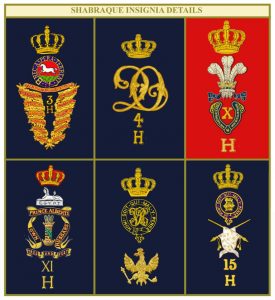
After the shabraques were finally abolished in 1896, there were still officers who used it. Photographs of the 10th Hussars (who seem to have always pushed the envelope when it came to dress) show them with it just prior to leaving for South Africa in 1899.
Despite this, the Shabraque was not discarded altogether. It was carried on the drum horses of many regiments well into the next century. Even those of regiments that discarded it for officer’s use early on (such as the 7th and 8th) still used it for the drum horse.
*The crossed flags of the 15th Hussars represent the sixteen captured by the regiment at Emsdorf in 1760 during the Seven Years War. They were presented to King George III upon their return home. The flags are of white silver specked silk with gold Fleurs-de-Lys upon them. They are often mistakenly said to be plain white.


